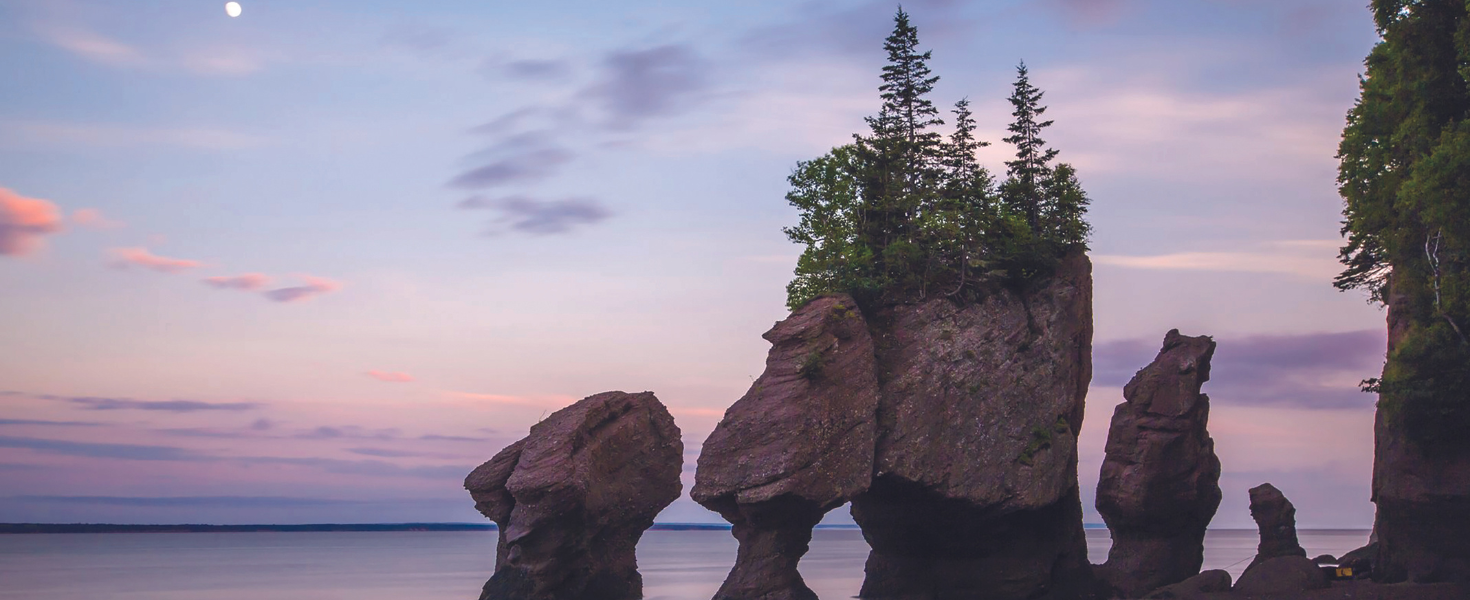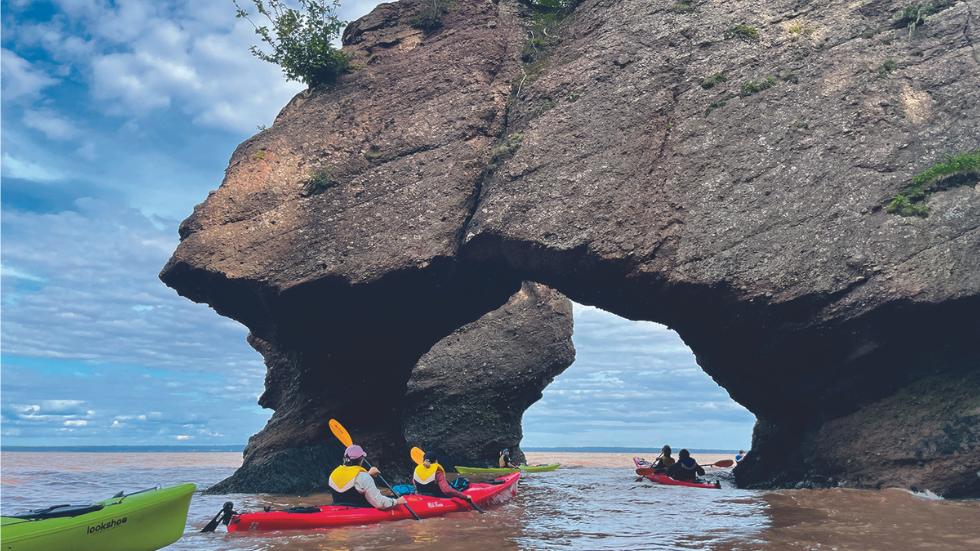The Ultimate Coastal Road Trip in New Brunswick Canada
Road-tripping along the Bay of Fundy showcases its famous tides, seaside towns, and unspoiled nature


As we walk single file on a narrow path on Machias Seal Island, my husband, Benjamin, and I follow our guide’s example, each carrying a tall stick pointed to the sky. Overhead, thousands of Arctic terns swoop and swirl. The birds are protective of this tiny uninhabited island in the lower Bay of Fundy and have been known to dive-bomb unsuspecting visitors. If that happens, our guide says, they’ll aim for the stick, rather than our heads.
At the end of the trail, we tuck inside a gray duck blind and open small rectangle viewing holes. Within minutes, I hear the pitter-patter of tiny feet on the roof.
.png?h=551&w=980)
Atlantic puffins migrate to Machias Seal Island each spring for mating season; Photo courtesy of New Brunswick Tourism
The stars of the show are here: Atlantic puffins, some 8,000 pairs of which arrive in mid-April and stay through August to breed. I watch through the viewing holes as they hop about on the rocks near our hiding spot. They are smaller than I imagined, with bright-orange bills and a penguin-ish walk. Their chainsaw-like calls resonate from burrows in the rocks.
The birds have no idea how delightful they are, but they’re why we’ve come. Some 1,800 pairs of razorbill auks and 500 pairs of common murres also call the island home, making it a paradise for birders like us.
Access to the island is strictly controlled and comanaged by Canada and the US. Each day, 15 Canadians are allowed to visit with Sea Watch Tours out of Grand Manan Island and 15 Americans with Bold Coast Charter from Cutler, Maine. Bookings open in January and sell out quickly.
.png)
The dramatic coastline of Grand Manan Island in the Bay of Fundy; Photo by Janna Graber
BAY OF FUNDY BEARINGS
Situated in the Atlantic Ocean between New Brunswick and Nova Scotia, Canada—and touching part of Maine—the Bay of Fundy’s unique funicular shape is the reason behind its famous tides, the world’s highest, reaching up to 56 feet. Some 160 billion tons of water rush into the bay with each tide change, enough water to fill the Grand Canyon twice.
One of the best ways to experience the picturesque bay is by a road trip in New Brunswick, with its enviable location revealing the dramatic Bay of Fundy to the southeast and the Gulf of Saint Lawrence to the northeast. It neighbors Québec to the north and Nova Scotia to the east. With only 800,000 residents in 28,143 square miles, there is plenty of room to roam.
It’s the perfect summer trip for those who like seaside villages, small towns and unspoiled nature.
SHEDIAC
Benjamin and I start our trip by flying into Moncton, New Brunswick’s largest city. After renting a car, our first stop is Shediac, a small Acadian community on the sea where Hôtel Shediac will be our home away from home. From there, the town is easy to explore on foot
.png)
Shediac, New Brunswick, boasts a 36-foot-long, 90-ton concrete-and-steel lobster sculpture; Photo by Emilie Iggiotti
Shediac bills itself as the Lobster Capital of the World, and a giant lobster sculpture in town proudly announces this boast. We sample fresh lobster at Bistro le Moque-Tortue, a whimsical Alice in Wonderland-themed restaurant in a historic home. Everywhere I look, I see images of Alice, the Cheshire cat, playing cards and more. The walls of Sébastien Després’ restaurant are also lined with shelves filled with more than 2,300 board games for guests to enjoy. Many of its dishes reflect Després’ Acadian heritage.
The Acadians are descendants of early settlers who arrived from France in 1604. When the British ordered all Acadians to leave in 1755, more than 10,000 did so. Some settled in the American colonies—many became the Cajuns of Louisiana—while others were sent to the Caribbean, France or England.
Eventually, some Acadians returned to what is now New Brunswick (which has a population of more than 25,000 Acadians), Nova Scotia and other parts of Canada, where Acadian culture and customs endure. Acadian French is a dialect with some characteristics of the French spoken in the 16th and 17th centuries. Today, French and English are the official languages of New Brunswick.
GRAND MANAN ISLAND
From Shediac, we make our way to the small town of Sussex. We get up early the next morning for the 90-minute drive, navigating through fogbound dips and curves, to Blacks Harbour. There, we catch the ferry to Grand Manan Island, where we stay at the lovely Compass Rose Inn.
.png)
New Brunswick’s 1829 Head Harbour Light Station, also known as East Quoddy Lighthouse; Photo by Janna Graber
Grand Manan is known for its historic lighthouses, some of which are still active and others of which have been restored by locals. The oldest, established in 1860, is Swallowtail Head Lighthouse, where interpretive signage tells its unique story. We also visit Southwest Head Lighthouse and, in the evening, Long Eddy Lighthouse, where we listen to the waves and look out over the sea as the sun sets.
ST. ANDREWS BY-THE-SEA
The next day, we head to St. Andrews, a charming resort town on the water. Our base is The Algonquin Resort, a New Brunswick icon that has been welcoming guests, including heads of state, royalty and everyday travelers, since 1889. It’s a destination all its own, with pools, a three-story waterslide, beach access, dining, a spa and more.
.png)
The Bay of Fundy is renowned for its whale-watching opportunities; Photo by Sheryl Nance-Nash
We could spend several days in St. Andrews, which has an inviting main street lined with small shops and seaside restaurants, but we’re here to get to know the many varieties of whales that call this area home in the summer. Zipping across the sea with six other passengers on a 24-foot rigid-hulled Zodiac Hurricane, we spot Minke whales, seals and porpoises. Our guide with Fundy Tide Runners is very knowledgeable, and we learn more about the Minke, the smallest of the baleen whales.
.png?h=551&w=980)
Lobster is a house specialty at the Beach Street Inn; Photo by Janna Graber
ST MARTINS
That evening, we head to the village of St. Martins. The highlight here is our stay at the Beach Street Inn, a boutique hotel in a historic home with 14 luxurious guest rooms, many with fireplaces. It’s known for its signature lobster dinner—a massive plate with a large fresh lobster, potato and vegetables—and we happily dig in.
FUNDY TRAIL PARKWAY
We start off early the next morning to drive Fundy Trail Parkway, which follows the forested coastline for 19 miles, dishing up breathtaking views of the bay around every curve, with occasional glimpses of waterfalls.
.png)
Long Beach Brook Falls is a 3/4-mile moderate hike from Fundy Trail Parkway; Photo by James Donald
Stopping several times to take photos and soak in the views, we also make a few longer stops to walk the Suspension Bridge Trail, which crosses a 275-foot suspension footbridge, and hike to Walton Glen Gorge, which is more than 525 feet deep and 1,000 feet across.
From the parkway, it’s a 45-minute drive to the tiny town of Alma, the perfect launching pad for exploring Hopewell Rocks.
HOPEWELL ROCKS PROVINCIAL PARK
The Bay of Fundy’s tides have sculpted the coastline into a fascinating geological mosaic of sea caves, arches and other rock formations. Exploring them during low tide and watching the water rise rapidly during high tide is an experience that can be had only in this part of the world.
At Hopewell Rocks Provincial Park, we explore the sandy shorelines and towering rock formations with park interpreter Heather Allen. As we walk, she tells us about the area’s 46-foot tides.
“If you get here at low tide,” Allen says, “you can walk out almost a mile on the coast. A few hours later, you can go kayaking over the top of these same beaches.”

Kayaking around carved rocks is a popular excursion at Hopewell Rocks Provincial Park; Photo by Janna Graber
Sure enough, we do just that. While walking with Allen, we stroll through the massive Lover’s Arch and other towering sea stacks. Then in the afternoon, we sign up with Baymount Outdoor Adventures, which gives us a quick lesson before we head out on the water for a guided tour.
We discover even more about the Bay of Fundy, designated a UNESCO Biosphere Reserve. Every 24 hours, we learn, there are two high tides and two low tides; the time between high tide and low tide is approximately 6 hours and 13 minutes.
As we paddle, the water is already receding from the bay, and within hours, the gigantic rocks at my eye level will be more than 40 feet in the air. I feel the tide ever moving beneath us, and I am once again awed by nature.
